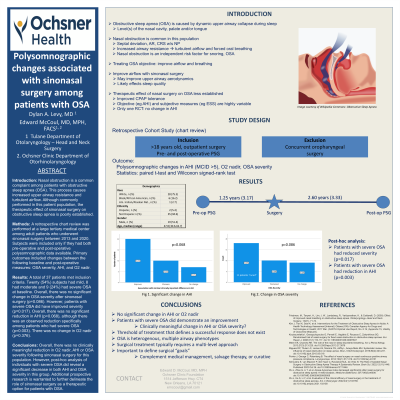Rhinology/Allergy
(1223) Polysomnographic Changes Associated With Sinonasal Surgery Among Patients Diagnosed With Obstructive Sleep Apnea
Monday, September 30, 2024
12:00 PM - 1:00 PM EDT

Disclosure(s):
Dylan Alexander Levy, MD: No relevant relationships to disclose.
Edward D. McCoul, MD, MPH: No relevant relationships to disclose.
Introduction: Nasal obstruction is a common complaint among patients with obstructive sleep apnea (OSA). This process causes increased upper airway resistance and turbulent airflow. Although commonly performed in this patient population, the therapeutic effect of sinonasal surgery on obstructive sleep apnea is poorly established.
Methods: A retrospective chart review was performed at a large tertiary medical center among adult patients who underwent sinonasal surgery between 2013 and 2020. Subjects were included only if they had both preoperative and postoperative polysomnographic data available. Primary outcomes included changes between the following baseline and postoperative measures: OSA severity, AHI, and O2 nadir.
Results: A total of 37 patients met inclusion criteria. Of them, (54%) subjects had mild, 8 had moderate and 9 (24%) had severe OSA at baseline. Overall, there was no significant change in OSA severity after sinonasal surgery (p = 0.086). However, patients with severe OSA did have improved severity (p = 0.017). Overall, there was no significant reduction in AHI (p = 0.068), although there was an observed reduction specifically among patients who had severe OSA (p = 0.003). There was no change in O2 nadir (p = 0.376).
Conclusions: Overall, there was no clinically meaningful reduction in O2 nadir, AHI or OSA severity following sinonasal surgery for this population. However, post-hoc analysis of individuals with severe OSA did reveal a significant decrease in both AHI and OSA severity in this group. Additional prospective research is warranted to further delineate the role of sinonasal surgery as a therapeutic option for patients with OSA.
- DL
Dylan Alexander Levy, MD
Resident
Tulane University
New Orleans, Louisiana, United States 
Edward D. McCoul, MD, MPH
Professor
Ochsner Health
New Orleans, Louisiana, United States
